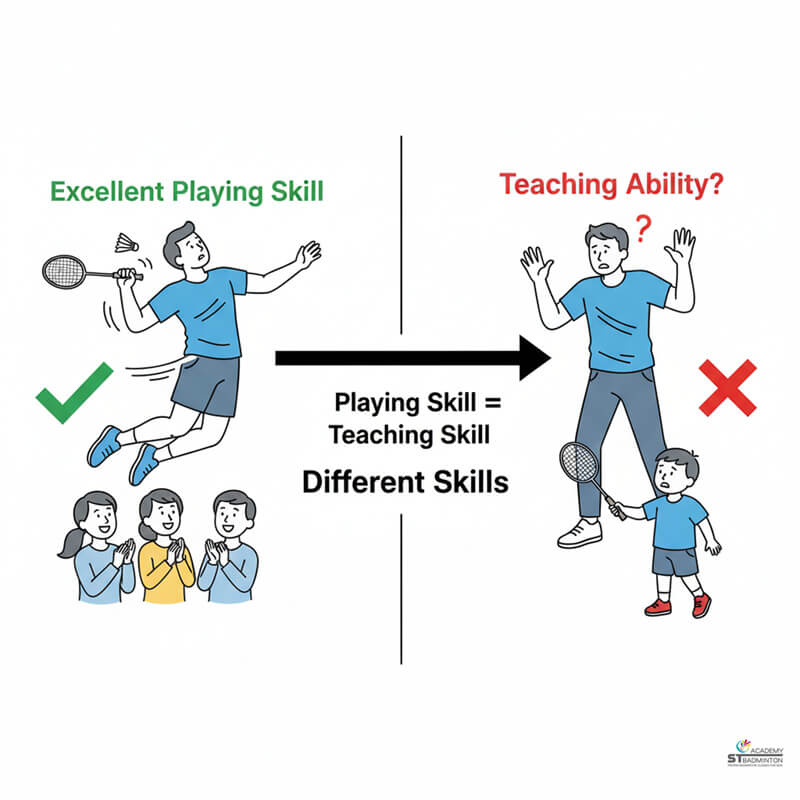Welcome to ST Badminton Academy’s badminton training in Malaysia! As a badminton training expert, I’m often asked how to overcome nerves in training. It’s not always easy and can be quite demoralizing for players of all levels. But it doesn’t have to be that way! With the right strategies, you can learn to manage your anxiety and get back on track with your practice sessions. In this article, I’ll share my best tips for overcoming nerves in badminton training so you can feel more confident and perform at your peak.
Everyone feels nervous before playing or practicing badminton – even professional players experience some level of performance anxiety. The good news is that there are practical ways to channel those feelings into something positive and use them as motivation during your next match or session. Keep reading to find out my top techniques for managing pre-game jitters and making sure they don’t interfere with your success on the court.
Recognizing Performance Anxiety
As a badminton training expert, I know how nerve-wracking it can be to step onto the court and face off against an opponent. Performance anxiety is very real and needs to be managed in order for athletes to get the most out of their game. Recognizing these triggers and identifying your fears is essential when trying to overcome nerves during badminton training.
The first thing you need to do is take some time before your match or practice session to observe yourself and recognize any feelings that may arise from facing competition or pressure. Are there any signs of physical tension such as tight muscles or rapid breathing? It’s important to become aware of your emotions so that you can better understand what causes them. Once you have identified what might trigger performance anxiety, it’s time to start addressing them.
By understanding the sources of nervousness, whether they are external factors like opponents or internal ones like self-doubt, we can begin to develop effective strategies for managing our mental state. Taking control over one’s thoughts will not only help reduce stress but also lead to improved performance on the court.
With proper surveillance and adequate preparation, players will find themselves more confident and relaxed when playing badminton. This increased comfort level makes all the difference between success and failure. To transition smoothly into this next section, let’s look at ways we can make use of these newfound insights about ourselves.
Understanding The Sources Of Nervousness
Recognizing performance anxiety is the first step in overcoming nerves during badminton training. Now, it’s time to understand some of the sources of nervousness and develop strategies for managing them. Acknowledging emotions can be an important part of recognizing why we become anxious and what drives us to feel that way. Taking a moment to reflect on your feelings before or after each practice session can help you identify any underlying anxieties that may be causing tension or distress.
Building confidence is key when trying to overcome nerves in badminton training. It starts with knowing yourself – understanding how different situations trigger or affect your behavior and adopting methods such as positive self-talk to maintain mental stability during intense moments. Additionally, staying up-to-date on your skillset by regularly reviewing techniques from professional players and coaches can help build assurance at all levels of play.
Practicing mindful breathing is another effective strategy for reducing stress while playing badminton. Focusing on taking deep breaths in through the nose and out through the mouth allows blood flow throughout the body which helps relax tense muscles, slow down heart rate, improve concentration, and sharpen focus. Taking even just a few minutes to breathe deeply before heading onto the court can make all the difference in helping you stay calm, cool, and collected throughout gameplay
Practicing Mindful Breathing
I’m a big believer in the power of mindful meditation and relaxation techniques when it comes to overcoming nerves during badminton training. Mindful breathing is an excellent way to begin calming down your mind before you even step on the court.
Firstly, I recommend that you take five deep breaths – inhaling for four counts and exhaling for six counts – at least 15 minutes before the start of your session. This will help settle any racing thoughts or anxious feelings so that you can stay focused on what’s important: executing your drills and improving your game. During practice, if anxiety begins to creep back up, stop and pause again for five more breaths – this time focusing each breath on letting go of anything that doesn’t serve as helpful energy while continuing with full presence in body and mind.
In addition to mindful breathing, setting simple intentions can also be effective in keeping yourself relaxed during matches or tournaments. This could look like repeating positive affirmations such as “I have trained hard for this” or “I am completely capable of playing well today” throughout the day leading up to the match itself. You can also get creative here by visualizing how you want the match to unfold from beginning to end; think about all the details including what shots you plan to hit, where they land on the court, etc., Ultimately, these strategies allow us to remain calm yet present when competing against our opponents.
Sticking To Your Routine
One of the best strategies for overcoming nerves in badminton training is to stick to your routine. Adopting rituals and developing discipline are key components in any successful athlete’s journey. Establishing a consistent practice schedule, setting reasonable goals, and tracking progress can help you stay focused on improving your game.
Creating an environment where you feel comfortable and confident is essential for competing at your highest level. Designating specific times for warming up, stretching, practicing drills, and cooling down will allow you to perform better when it counts. Taking regular breaks throughout the day helps clear your mind so that you always come back ready to give 100%.
The importance of having a positive attitude cannot be overstated either. Staying motivated even during difficult moments requires self-reflection, as well as constructive criticism from coaches or teammates who understand your goals and objectives. Remaining optimistic no matter what outcome will help increase resilience over time. Moving forward, engaging in positive self-talk can be beneficial in calming pre-match jitters and helping keep negative thoughts at bay.
Engaging In Positive Self-Talk
I’m always impressed when I see athletes being able to identify their negative thoughts and replace them with positive affirmations. It’s not easy to do, but it helps to build confidence and reduce nerves during badminton training. So, I’d suggest that athletes take the time to notice when they’re having negative thoughts and reframe them into positive ones. Once that becomes a habit, it’ll help them stay calm and focused during their training sessions.
Identifying Negative Thoughts
One of the best strategies for overcoming nerves in badminton training is to identify negative thoughts. As a badminton trainer, I see so many players battling with fear and self-doubt before they step onto the court. It’s important to distinguish what triggers these feelings so you can address them head-on. The first step is writing down your fears and anxieties around playing – that way, you can start tackling those doubts one by one.
Seeking support from friends or family members who can help encourage positive thinking is also key; this could be as simple as reminding yourself of how far you’ve come in terms of skill development or taking time out for some deep breaths between games. Whatever it is, having someone there to offer words of encouragement will get rid of any lingering negativity! With patience and dedication, you’ll soon find yourself feeling more confident each time you hit the courts.
Positive Affirmations
| Using Positive Affirmations in Badminton Training | Description |
|---|---|
| Incorporate Positive Affirmations | It’s also important to make use of positive affirmations when engaging in positive self-talk. Positive affirmations can be powerful tools for helping you stay motivated and confident during badminton training sessions. I suggest writing down a few affirming statements that focus on the progress you’ve made, such as ‘I’m getting better at my backhand every day’ or ‘I have improved so much since last season.’ Reciting these affirmations out loud before each game will boost your confidence and help keep your mind focused on the task ahead! |
| Seek Support from Friends and Family | Seeking support from friends or family members who can remind you of how far you’ve come is key too – it helps to know there are people rooting for you while you work hard towards achieving success in badminton. With patience and dedication, incorporating positive affirmations into your pre-game routine will give you the mental edge needed to take your performance up a notch! |
Setting Realistic Expectations
When it comes to overcoming nerves in badminton training, setting realistic expectations is key. As a badminton training expert, I have seen many athletes get overwhelmed by their own goals and end up feeling discouraged when they don’t meet them.
That’s why it’s important not just to set reasonable goals for yourself but also set boundaries that allow you to make progress without getting too stressed out or overworked. By setting clear-cut objectives and holding yourself accountable, you can gradually build your confidence as an athlete while still maintaining healthy stress levels.
Building self-confidence is essential to any successful badminton career; however, this can be difficult if your expectations are too high or unrealistic. It’s important to remember that improvement takes time and setbacks should be expected along the way.
Start with small achievable goals instead of focusing on massive improvements right away – these smaller wins will help keep you motivated and focused on reaching your long term goal. Additionally, try breaking down big tasks into smaller chunks so that each step towards success feels manageable and rewarding.
Having a positive attitude towards mistakes is another great way to stay calm during training sessions and boost morale overall. Learning from mistakes rather than beating yourself up about them allows for personal growth both mentally and physically which eventually leads to more satisfying results in the end. So take things slow, practice patience, and focus on building confidence through incremental successes!
Visualizing Success
Visualizing success can be a powerful tool for overcoming nerves in badminton training. By taking the time to imagine yourself performing at your best and playing with confidence, you can create an internal psychological shift that will help you stay focused on what’s important. Here are some tips for using visualization to improve your performance:
| Mental Imagery for Badminton Success | Description |
|---|---|
| Create a Mental Image of Success | Create a mental image of success – Before each practice session or match, take a few moments to close your eyes and imagine yourself feeling relaxed yet confident as you play. Visualize hitting every shot accurately, rallying smoothly, and executing all of your strategies successfully. |
| Focus Attention on Positive Outcomes | Focus attention on positive outcomes – When conflicting thoughts enter your mind during competition, recognize that they’re counterproductive and choose instead to focus on achieving the desired result. Keep coming back to those positive images of success that you created earlier, allowing them to guide your actions throughout the duration of the game. |
By capitalizing on visualizations such as these, badminton players have an invaluable opportunity to develop their skills while cultivating a mindset conducive to peak performance. With this kind of forethought and preparation under their belts, athletes can approach each situation with poise and assurance — ready to move on to the next step: taking time for rest and recovery.
Taking Time For Rest And Recovery
I understand how nerve-wracking badminton training can be, and I’m here to tell you that it’s okay to take time for rest and recovery. It’s important to do this in order to avoid burnout and gain confidence.
Taking a break doesn’t mean you’re giving up or taking the easy way out – instead, it means that your body needs some extra recovery after hard workouts.
It also gives your mind a chance to process everything that happened during practice so you can come back with more energy and focus than before. Plus, having regular breaks will help prevent injuries from happening due to overtraining or exhaustion.
If you want to get the most out of your badminton training sessions, then make sure to give yourself enough time for rest and recovery. Not only will this keep you feeling energized and motivated, but it’ll also give you the opportunity to reflect on what went well during practice as well as how you could improve next time around.
Taking these moments away from the court will ultimately allow you to come back stronger and better prepared when it’s time for another session!
Frequently Asked Questions

How Can I Tell If I’m Feeling Performance Anxiety?
If you’re worried that performance anxiety is getting in the way of your badminton training, there are a few things to look out for. You might notice yourself having difficulty focusing on the court or feeling overwhelmed by pressure. It’s important to reach out to someone who can help, like a mentor or coach, and practice visualization exercises.
Visualization helps to break down movements into manageable steps so that they become easier when put into action. Taking these measures can help make sure you stay confident and focused during your training sessions!
How Long Does It Take Before I Start Seeing Results From Mindful Breathing?
Managing stress and focusing attention can be a challenge when doing badminton training. Mindful breathing is an effective tool to help with that, but how long does it take before you start seeing results? Generally speaking, the longer you practice mindful breathing techniques, the better your ability to manage stress and stay focused during badminton training.
You’ll start noticing improvements right away, but for maximum effect, it’s important to use mindfulness regularly over a period of time. With regular practice, you should experience significant benefits within just a few weeks! Other than choosing a good racket and also remember to choose the best racket restring in Malaysia.
What Specific Steps Should I Take To Create A Routine For Badminton Training?
Are you ready to take your badminton training routine up a notch? Developing an effective and consistent practice plan is essential for success. Start by focusing on both your mental focus and physical conditioning – this will help create the foundation for sustained performance improvements. Try incorporating dynamic warm-up exercises before each session, such as jogging or jumping rope; these will boost your energy level while providing much-needed cardio benefits.
Make sure to set aside time during your training sessions to work on honing specific skills like serves, backhands, and footwork drills. Finally, make sure to finish with cool-down stretches so that you don’t experience any lingering soreness after play. With proper planning and dedication, soon enough you’ll be hitting those winning shots!
How Often Should I Engage In Positive Self-Talk?
It’s important to engage in positive self-talk when training for badminton. Building your confidence through affirmations is key, so I suggest you do this at least once a day – either before or after practice. You can even create meaningful mantras that are specific to the game of badminton and your own individual goals; these will help remind yourself just how capable you are!
How Do I Create Realistic Expectations For My Badminton Training?
Creating realistic expectations for your badminton training is like building a house – it takes time, dedication, and preparation. Visualizing success before you even step foot on the court can help set the foundation of positive mental preparation. Before each practice or match, I suggest taking 5-10 minutes to close your eyes and imagine yourself succeeding in various scenarios; this will give you confidence no matter what the result may be. Additionally, focus on smaller goals rather than big results overnight, as these are more achievable and rewarding along the way.
Learn How to Overcome Nerves in Badminton Training Malaysia
Badminton training can be a daunting task, especially if you’re feeling the pressure of performance anxiety. But with mindful breathing and positive self-talk, all those nerves will melt away in no time! Take it step by step, set achievable goals, and before you know it your badminton skills will skyrocket to heights never seen before – it’ll feel like winning an Olympic gold medal!
Practicing these strategies regularly is sure to make a world of difference when it comes to overcoming nerves during badminton training. So take my advice: don’t be afraid to push yourself out of your comfort zone – the rewards are exponential!





